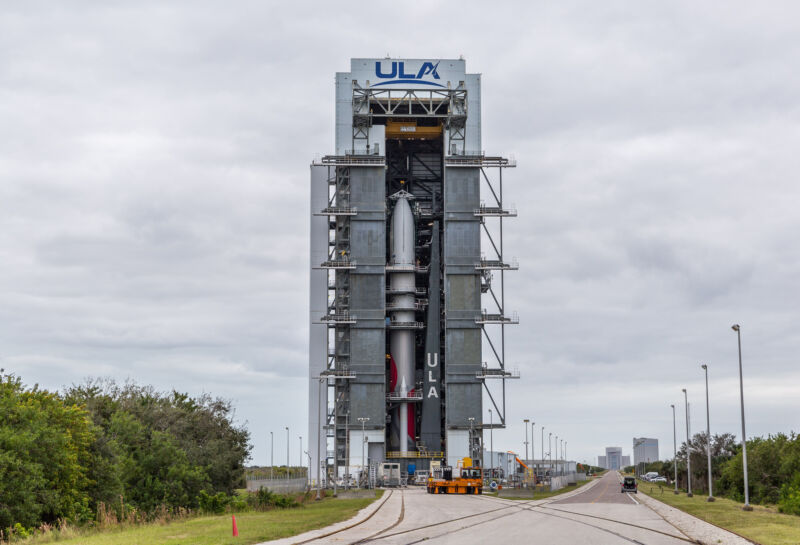ULA LLAP —
This marks an absolutely pivotal moment for the 20-year-old launch company.

Enlarge / United Launch Alliance hoists the Certification-1 payloads atop the Vulcan rocket in the Vertical Integration Facility adjacent to Space Launch Complex-41 at Cape Canaveral Space Force Station.
United Launch Alliance
It’s nearly time. After years of delays, billions of dollars in federal funding, and a spectacular second-stage explosion, the large and impressive Vulcan rocket is finally ready to take flight.
United Launch Alliance’s heavy lift vehicle underwent its final review on Thursday, and the company cleared the rocket for its debut flight. With weather looking favorable, the Vulcan rocket is on track to lift off at 2: 18 am ET (7: 18 UTC) on Monday from Cape Canaveral Space Force Station in Florida. The mission’s primary payload is a lunar lander built by Astrobotic, and the launch will be streamed live here.
This marks an absolutely pivotal moment for the 20-year-old launch company, which has gone from the titan of the US launch industry to playing a distant second fiddle to its one-time upstart competitor SpaceX. Last year, SpaceX launched 98 rockets. United Launch Alliance, or ULA, tallied just three. The owners of ULA, Lockheed Martin and Boeing, are also on the cusp of selling the launch company if they can find a buyer willing to pay the right price. And critically, for the first time, ULA will be flying a new vehicle it designed and developed on its own—a rocket with some but not a majority of its heritage from the legacy Atlas and Delta rockets that have flown since the Cold War.
So yeah, it’s a moment.
A little history
A quarter of a century ago, two of America’s largest aerospace contractors, Lockheed and Boeing, were the national leaders in providing launch services for the US military and many of NASA’s science missions. But they struggled to capture commercial satellite launches in an emerging market. Lockheed, with its Atlas rockets, and Boeing, with its Deltas, could not compete with Europe-based Arianespace and Russia on price. So the two US contractors doubled down on their competition for US government launch contracts.
The competition grew ugly, with allegations that Boeing stole rocket designs from Lockheed. The US Department of Justice began investigating how Boeing acquired tens of thousands of pages of trade secrets belonging to Lockheed Martin. There were lawsuits, and then questions about whether Boeing’s rocket business was viable. Military officials began to worry that if Boeing stopped flying the Delta, their only pathway into space would be through a Russian engine—the RD-180 that powered Lockheed’s Atlas V.
To ensure it had redundant access to space on two different rocket families, the military stepped in and arranged a shotgun marriage. The Department of Defense brokered a deal in which Lockheed and Boeing would merge their rocket-building ventures into one company, United Launch Alliance, in 2005. The parents retained a 50 percent ownership stake, and to sweeten the pot, the military agreed to pay a subsidy of about $1 billion a year.
Everything seemed to be working out well until SpaceX started launching rockets.
A little rivalry
ULA had tried to kill the baby. When SpaceX sought a launch site for its Falcon 9 rocket at Cape Canaveral in 2007, the parents lobbied the Air Force brass hard to stop the lease of Space Launch Complex-40 to Elon Musk and his rocket company. But the commander of the 45th Space Wing with oversight of Cape Canaveral, Gen. Susan Helms, approved the lease anyway.
Since then, ULA and SpaceX have been uneasy bedfellows in Florida, working side by side at nearby launch pads. Some of the rivalry was good-natured. Every week, for a while, engineers from SpaceX and ULA would meet up at Hogan’s Irish Bar in Cape Canaveral for trivia night. They would vie for nerd supremacy, drinking Guinness and blowing off steam.
But there have been more difficult confrontations. Musk kept pointing out the $1 billion subsidy at Congressional hearings—ULA officials bristled at the characterization of this ELC payment as a subsidy, but in effect, that’s what it was—and arguing that SpaceX’s Falcon 9 rocket could fly many of the military’s missions for much-reduced prices.
The issue came to a head in 2014, when the Air Force and ULA announced a new agreement for 36 national security launches to be flown during the remainder of the decade. ULA’s chief executive at the time, Mike Gass, hailed this “block buy” agreement because it would save the government $4.4 billion. Musk seethed. By then, his Falcon 9 rocket had launched eight times, all successfully. He sued the US government to stop the block buy and open up competition for the Falcon 9.
Several months into the lawsuit, SpaceX and the Air Force entered mediation. As part of the settlement, the military agreed to accelerate the certification of the Falcon 9 rocket and open up a number of the block buy launches to competition. SpaceX launched its first national security payload in 2017. SpaceX has not really looked back since.

Enlarge / Jeff Bezos (right), the founder of Blue Origin and Amazon.com, and Tory Bruno, CEO of United Launch Alliance, display a small-scale version of the BE-4 rocket engine during a press conference in 2014.